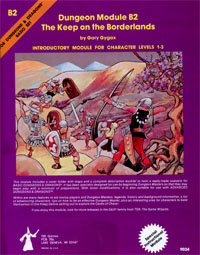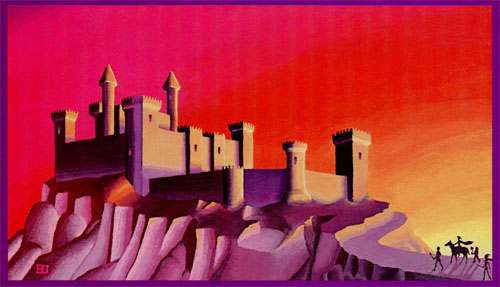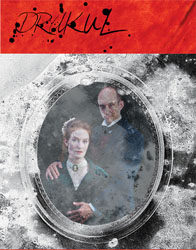 In “(Re)-Running the Megadungeon” I talked about how to keep a dungeon complex fresh by restocking the room key and using wandering monster tables as a form of low-tech procedural content generation. In “Wandering Adventures” I talked about how the OD&D wandering monster tables could be used to generate entire adventures. Now I want to build on those ideas by touching on the basic concept of factions in the dungeon.
In “(Re)-Running the Megadungeon” I talked about how to keep a dungeon complex fresh by restocking the room key and using wandering monster tables as a form of low-tech procedural content generation. In “Wandering Adventures” I talked about how the OD&D wandering monster tables could be used to generate entire adventures. Now I want to build on those ideas by touching on the basic concept of factions in the dungeon.
To immediately boil the idea down to its core: If your dungeon has a life beyond the activities of the PCs, it is much easier to revitalize the dungeon between delves. The life of the dungeon will naturally generate the ideas necessary to restock the dungeon (and, thus, carry a lot of the weight for you). This becomes even easier if the dungeon contains multiple, independent factions. (And even moreso if these factions are openly hostile to each other.)
Nor does this have to be something that you need heavily pre-plan. It can largely just be a matter of keeping one eye on it during your restocking process: “Okay, the PCs killed 70% of the orc population on Level 3. Who can take advantage of that? What will the Orc King’s response be? Actually, wait, they killed the Orc King. Have the orcs broken into factions? Could the Red Prince (I just made that name up) have allied with the goblins on Level 2 to push his claims? How will the other orcs feel about being asked to co-exist with lowly goblins? Will they turn to the Voodoo Necromancer (just made that up, too) who was once the Orc King’s advisor?” That’s about 15 seconds of brain-storming. Follow it up with a couple minutes of actual prep and you’ve got orc-and-goblin warbands with faces painted bright crimson squaring off against orc warriors ‘roided out on alchemical strength-boosters wearing the bone fetishes of the Voodoo Necromancer. It doesn’t even really matter if the PCs get involved in the actual politics of the situation: Even if they just hack their way through these orcish factions, they’ll (a) recognize that the dungeon has changed in their absence and (b) get some unique and interesting hacking out of it.
(You can see a similar real-play example of this in Delve Seven of “(Re-)Running the Megadungeon” when the elementalist gets killed.)
So, obviously, there’s nothing wrong with winging it. In the process of winging it, however, I’ve found it generally useful to prep two key pieces of information:
- Identify each faction.
- Identify the territory controlled by each faction.
Most of the time, it’s not necessary to get really obsessive with this. For example, in the Caverns of Thracia I don’t really have much more than a general sense that “the cultists control this chunk of the map”, “the lizardmen control these rooms”, “the anubians are based out of this complex”, and the like.
My understanding of the complex is fairly amorphous, and putting more detail into it is probably counter-productive: It’s unlikely to ever be noticed by players, it’ll bog down your prep, and it’s rarely representative of the fairly amorphous nature of contested territory. Precision will also tend to bog down your ability to flexibly interpret the results from your random encounter tables.
(Of course, if you’re designing a scenario in which particular focus or importance is placed on factional play, more detail may be merited.)
RANDOM FACTION INTERACTION TABLES
With that being said, it might be valuable to build some quick, light tools that will allow you to procedurally generate the ebbing shifts of factional fortunes in the dungeon. For this purpose, let’s turn to the Caves of Chaos from the classic B2 Keep on the Borderlands.
For those unfamiliar with this module, the Caves of Chaos are particularly useful for this purpose because they’ve already been conveniently split into factions: Essentially you’ve got a small valley full of caves, with each cave leading to an interconnected system of caverns and serving as the lair for one of several chaotic factions. The factions are:
(“Wandering Adventurers” refers to an NPC party entering the Caves of Chaos.)
FACTION CONFLICT CHECK: After each visit to the caves by a party of PCs, make a faction conflict check. Roll 1d6. On a roll of 6, conflict has broken out between the factions. Roll twice on the faction table to determine which two factions have come into conflict. (If you roll the same number twice, either re-roll or assume some sort of civil strife.) Then roll on the Conflict Resolution Table:
Stalemate Skirmish: The factions are largely unaffected by the conflict. Their forces may have been reinforced, or you may wish to subtract 1 or 2 members from one of their encounters. (The conflict may leave them ripe for alliances against their recent foes; or leave a chamber showing recent signs of conflict; or a couple of corpses tossed onto the valley floor to be feasted on by the owlbear.)
Faction Damaged: A damaged faction has suffered losses equal to roughly 25% of their strength. Subtract 1d4 members from each encounter (keyed or random) with that faction.
Faction Crippled: A crippled faction has suffered loses equal to roughly 50% of their strength. Eliminate entire encounters or subtract 1d12 members from each encounter (keyed or random) with that faction.
Faction Destroyed: A destroyed faction has been eliminated. Their lair may lie empty, be occupied by the other faction involved in the conflict, or restocked randomly. Their population has been killed, driven off, or enslaved.
Factions Unite: The two factions have allied with each other. (One of the leaders may have been killed. The alliance may be for some short-term goal. Or the populations might be fully intermixed between the lairs.)
USING THE TABLES
Like a random encounter table, the output here is designed to be flexibly interpreted. Once again, the Caves of Chaos are great for this sort of thing because it already includes some short notes regarding the relationships between the factions. (For example, the owlbear is described as having recently munched on some gnolls. The two orc chieftains have a secret meeting room that only they know about. And so forth.)
Mostly for the fun of it, I’m going to roll up a couple actual examples using these tables. We’ll start by assuming that I’ve just rolled a “6” on my Faction Conflict Check and go from there:
1. DETERMINE FACTIONS: I roll 1d12 twice, generating 9 and 5. That’s the Minotaur and the Ogre.
2. DETERMINE OUTCOME: I roll 1d8 and get 8. That’s Factions Unite.
3. INTERPRET RESULT: The Minotaur and the Ogre are the two solo factions in the Caves. (There’s only one Ogre and one Minotaur.) Scanning their entries, I see that the ogre is willing to sell his services to the highest bidder and the minotaur has a lot of money. So let’s say that the minotaur has hired the ogre for some purpose. What could it be? Well, the minotaur is willing to help the bugbears if they pay him in slaves. What if the bugbears cheated the minotaur and now he wants a little help to get the payment he feels is his due? That sets up a scenario where the PCs could arrive in the valley to see bugbears fleeing from their caves; or find bugbears shackled in the minotaur caverns; or just the minotaur and ogre huddling up in the minotaur’s cavern while they plot the glories of their revenge.
Let’s do it again:
1. DETERMINE FACTIONS: I roll 4 and 12. That’s Goblins and Wandering Adventurers.
2. DETERMINE OUTCOME: I roll a 5 for Both Factions Damaged.
3. INTERPRET RESULT: This one is pretty easy to figure out. A group of adventurers entered the goblin caverns, wreaked some havoc, and then got driven off.
4. GOBLIN ENCOUNTERS: There are 36 goblins total in this lair. A 25% loss would represent 9 goblins. I can represent this loss pretty easily be eliminating the wandering patrol of 6 goblins (the surviving goblins have bunkered down) and the 4 goblins guarding the store room.
5. ADVENTURERS: Where’d they go? Well, let’s say it was a party of 4 adventurers. One of them is dead and his corpse can be seen on a spike outside the goblins’ lair. The rest are either (a) camping nearby and looking for allies; (b) sold to the hobgoblin slavers; or (c) both.
FINAL THOUGHTS
It should be pretty easy to see how this simple system can be used to add a little quick spice to the complex between PC visitations. Combined with the ability to simply use some generic wandering monster tables to rapidly determine the new inhabitants of any lair complex emptied out by the PCs, it’s pretty easy to see how the Caves of Chaos could be easily used pretty much endlessly for low-level adventuring.


 Under the electric lights of London, Mina is enamored of a handsome young solicitor. But when Jonathan disappears on a business trip and Mina is approached by an alluring foreign prince, a shadow falls over their lives. Now, seven years since the defeat of the vampire, the wounds of betrayal remain… until their private journals are published under the name “Bram Stoker” and they must either face the past or be destroyed by it.
Under the electric lights of London, Mina is enamored of a handsome young solicitor. But when Jonathan disappears on a business trip and Mina is approached by an alluring foreign prince, a shadow falls over their lives. Now, seven years since the defeat of the vampire, the wounds of betrayal remain… until their private journals are published under the name “Bram Stoker” and they must either face the past or be destroyed by it.











